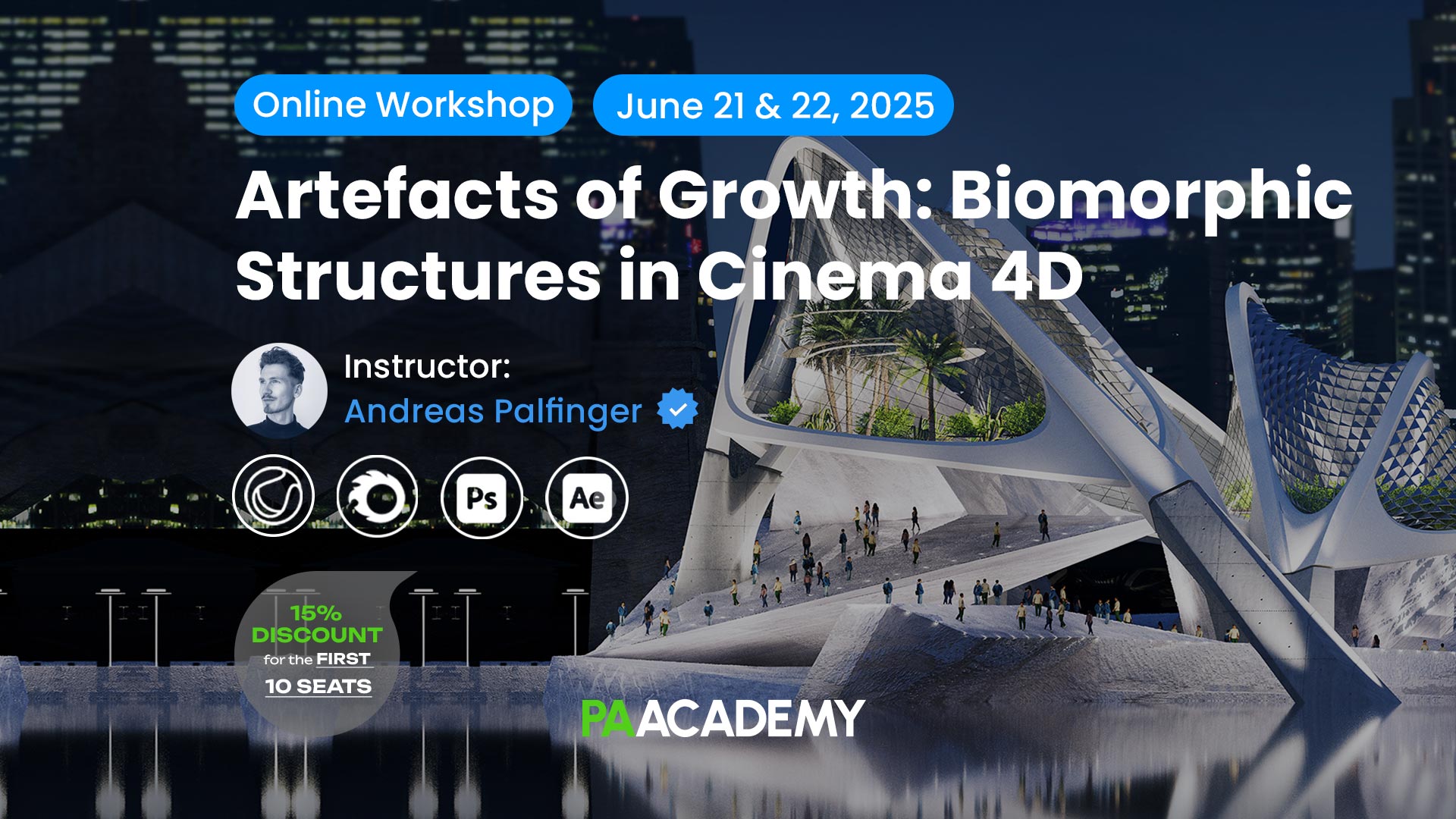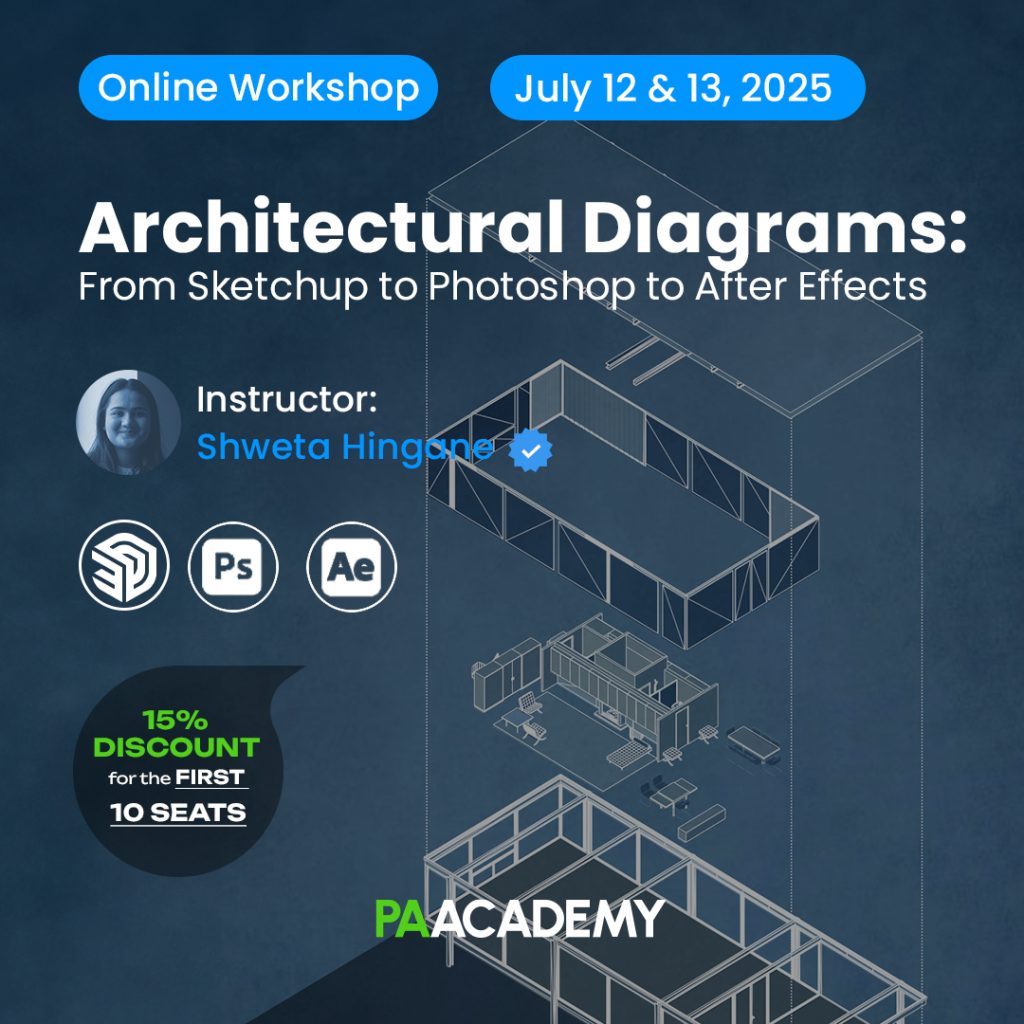Topic: Architectural Follies 2.0
Date: June 29 – 30, 2024
Time: 14:00 – 18:00 GMT
Format: Online on Zoom
Duration: 2 Sessions (8 Hours)
Registration Deadline: June 28th, 2024
Total Seats: 50 seats
Difficulty: Beginner – Intermediate
Language: English
Certificate: Yes
General Registration: 90 EUR
Join free: with Full Access membership
Fee For Digital Members: 77 EUR (15% discount available only for Digital Members)
Organized By: PAACADEMY
Tutor: Erick Carcamo
Recordings: Recordings will be available for all participants afterward indefinitely.
Introduction to Architectural Follies 2.0:
This course is a sequel to Architectural Follies. During the course, we will explore the emotional response, also known as “Affect,” of folly within the context of Parametric Design (intellect). Parametric design is a powerful approach that combines mathematical algorithms, computational tools, and creative intuition to generate complex and dynamic architectural forms. In the Architectural Follies 2.0 workshop, we will explore how parametric design influences our perception of architectural follies by examining the interplay between intellect and emotion.
Key Topics:
1. Introduction to Parametric Design:
- Understanding the principles and techniques behind parametric design.
- Exploring case studies of iconic parametric architectural projects.
2. Emotional Impact of Follies:
- Analyzing the emotional responses evoked by architectural follies.
- Discussing the role of aesthetics, symbolism, and context in shaping affect.
3. Parametric Tools and Techniques:
- Hands-on exploration of MAYA software.
- Creating parametric designs that elicit specific emotional reactions.
4. Case Studies and Critiques:
- Reviewing existing folly designs through the lens of affect.
- Engaging in critical discussions about the emotional impact of architectural interventions.
5. Design Studio Projects:
- Applying parametric principles to design your own folly.
- Considering both intellectual rigor and emotional resonance in your design process.
The Scope of the Workshop:
This workshop delves into the emotional response within parametric design, focusing on creating architectural follies. Through theoretical discussions and practical exercises, participants will explore the interplay between intellect and emotion in architectural design. Key topics include:
- An introduction to parametric design principles.
- Analysis of emotional impact.
- Hands-on exploration of parametric tools.
- Design studio projects aimed at creating unconventional structures.
The workshop challenges traditional notions of form, fostering designs that provoke thought and emotion.
Methodology of the Architectural Follies 2.0:
Inspirational Images
Choose a series of inspirational images that exhibit “structural” qualities. Look beyond architecture—consider patterns, textures, and connections. These images will serve as touchstones for your folly’s development.
- Applied Texture: Imagine bodies (geometry) connecting and dissimulating through intricate patterns and textures. How can you create a sense of both separation and unity?
- Applied Geometry: Extend, interlock, and engage bodies within your folly. Blend, twist, mesh, and boolean geometric forms to achieve unexpected compositions.
Structural Innovation
Your folly’s structural design must break free from off-the-shelf components. Avoid prefabricated trusses and standardized assemblies. Instead, delve into the root material and geometrical properties of architectural structures. Design your own structural space—one that defies conventions.
Scalelessness
Think beyond traditional scales (S | M | L). Embrace a scaleless conception. Maya, our chosen software, alters our perception of scale. Let the architectural problem dictate the appropriate scale for your folly.
Strategic Approaches
- Repetition | Multiplication | Mutation: Explore cellular logic. Radicalize your project by manipulating units. Use repetition, multiplication, and mutation to create dynamic architectural systems.
- Formal Systems: The design of your folly extends beyond its physical form. Consider the formal systems it embodies—the architectural physiology. How do these systems interact with space, movement, and emotion?
Recipe for Your Folly
- Methodology: Blend STRUCTURE, SKIN, and MASS. Structure provides organization, skin defines surfaces, and massing shapes the overall composition.
- Digital Materiality: Play with HARD BODIES (rigid elements) and SOFT BODIES (fluid, deformable elements). Explore textures, behaviors, and material expressions.
- Ground: Situate your folly within an existing or fictional site. Consider context, topography, and interaction with the ground.
Personal Aesthetics
- Formal Characteristics: Address formal qualities intentionally. How will they influence the perception of your folly?
- Spatial Experience: Remember that design shapes experience. How you design the space affects how it will be used and felt.
- Ornamental Consciousness: Consciously consider how the body perceives your architectural object. Ornamentation isn’t just decoration—it’s an embodied experience.
- Interiorities and Cavities: Explore the interplay of solid and void. How do interior spaces interact with external forms?
The charm of a folly lies in its delightful absurdity and ability to provoke thought and emotion without practical function.
Objectives of the Architectural Follies 2.0:
- Exploring Alternative Articulations: In the Architectural Follies 2.0 workshop, we will explore alternative ways of articulating digital geometry and materiality, such as parametric design and algorithmic modeling. Understanding how these elements interact gives you insights into designing more dynamic and responsive architectural solutions.
- Morphological and Geometrical Techniques: During the Architectural Follies 2.0 course, we will cover techniques that enhance architectural forms’ visual strength and stability. These methods will empower you to create a static framework, allowing a hierarchy to emerge.
- Performance-Based Design: Digital Performance is at the core of our exploration. You’ll learn to balance morphological, geometric, and digital material characteristics for optimal structural performance.

Program:
Day 1:
- Intro Lecture – Affect (emotional response to imagery) vs. Effect (Technique and Technology)
- Intro Tutorial for MAYA software, interface, and Polygon modeling.
- Image results.
- Advancing Tutorial – modeling, animation intro, technique-driven by Project Assignments
- Q&A
Day 2:
- Lecture — Affect (emotional response to imagery) vs. Effect (Technique and Technology)
- Advancing tutorials, Animation, polygon modeling, MASH
- Rhino intro and workflow.
- ENSCAPE intro and rendering.
- Project Development and Reviews
- Q&A
Software:


Instructor:
Erick Carcamo
Erick Ca?rcamo is the Principal and co-founder of @AllBlackForm (IG), an international architectural practice based in Los Angeles. As a designer, Erick has dedicated himself to innovation and technology within the field of architectural thinking and teaching processes. His expertise extends from his graduate thesis and revolves around researching experimental techniques and strategic thinking for manipulating form. He applies these design abilities to understand spatial and organizational issues central to architecture thoroughly. Originally from El Salvador, Erick holds a master’s degree in Advanced Architectural Design from Columbia University, GSAPP, and a bachelor’s degree from The Southern California Institute of Architecture (SCI-Arc). He has established an impressive 15-year academic teaching career alongside his professional work. Erick has taught numerous design studios and visual studies seminars at various universities in the USA and Europe. Notable institutions include the Southern California Institute of Architecture, UPenn School of Design, Woodbury University, and he has previously taught at Yale School of Architecture, GSAPP, and the Institute of Architecture at the University of Applied Arts in Vienna, among others.
During his active teaching career, Erick has coordinated both undergraduate and graduate-level studios, providing him with the opportunity to teach core and experimental option studios. In addition to his university teaching appointments, Erick has developed a Workshop teaching model emphasizing the fusion of technique and conceptual immersion, leveraging parametric software. His commitment to innovative pedagogy proposes to enrich architectural education.
Important Notes:
- The “Architectural Follies 2.0 ” Studio workshop by PAACADEMY will start on Saturday, 29th June 2024, at 14:00 (GMT).
- Total sessions: 2 Sessions
- The teaching duration per session will be 4 hours.
- Students will have time for a break between teaching hours.
- Each session and the entire studio will be recorded, and videos will be available for participants just a day after the class for unlimited time.
- PAACADEMY will provide a certificate of attendance.
- The studio has limited seats. Tickets are non-transferable & non-refundable. Please read carefully before you register.

Topic: Architectural Follies 2.0
Date: June 29 – 30, 2024
Time: 14:00 – 18:00 GMT
Format: Online on Zoom
Duration: 2 Sessions (8 Hours)
Registration Deadline: June 28th, 2024
Total Seats: 50 seats
Difficulty: Beginner – Intermediate
Language: English
Certificate: Yes
General Registration: 90 EUR
Join free: with Full Access membership
Fee For Digital Members: 77 EUR (15% discount available only for Digital Members)
Organized By: PAACADEMY
Tutor: Erick Carcamo
Recordings: Recordings will be available for all participants afterward indefinitely.





















Leave a comment